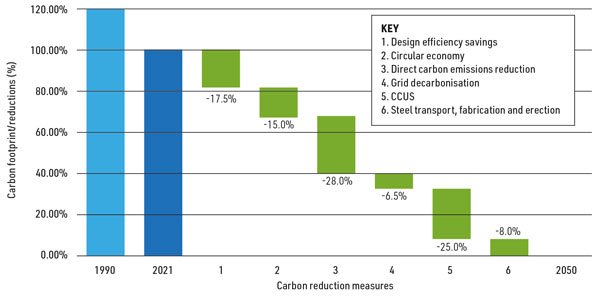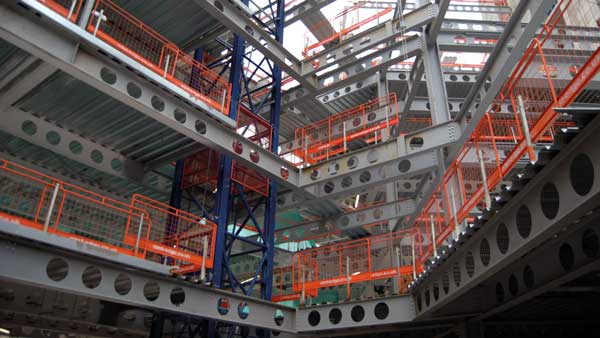Projects and Features
Roadmap to decarbonised steel construction

The route to net-zero carbon for steel construction has been clearly set out in a Roadmap from the BCSA, signposting the new and developing technologies that will allow net-zero steelmaking to be achieved by the 2050 target date.
The world now accepts that it has to grapple with the climate change emergency on a broad range of fronts, and all construction materials have found themselves under a harsher sustainability spotlight than ever before. The steel industry is committed to achieving net-zero steelmaking by 2050 and is already investing significant sums in new technologies to decarbonise steelmaking while investigating how best, and how quickly, decarbonising can be made to happen.
Decarbonised steel structures will be a reality by the UK net-zero carbon target date of 2050 thanks to the collaborative efforts of designers, steelwork contractors and steel producers to devise both demand side and supply side reduction measures. There will be costs associated with the transition, but steel is regarded as the cheapest to decarbonise of all the ‘harder to abate’ industries, with a McKinsey report putting the average abatement costs at £90 per tonne of steel.
The route to our decarbonised steel future has been clearly set out in a Roadmap produced by the BCSA, with substantially reduced emissions by 2030 as a key milestone along the way. As the Roadmap shows, there are multiple options to decarbonisation, using technologies which are either available now or at the industrial pilot stage.
The destination at the end of the Roadmap is a genuinely circular and sustainable structural steel sector in which steel structures are sustainably constructed, adapted and extended to prolong their lifetimes, and easily deconstructed for either re-use or recycling at end of life.
Progress already made
Steel already has a strong sustainability benefits to build on:
- Steel structures are lightweight and structurally efficient
- Steelwork is efficiently fabricated offsite offering quality assured, fully tested and traceable products
- Steelwork design and fabrication is BIM-led providing a digital-twin enabling future reuse
- On-site construction is safe and fast with minimal local adverse environmental impacts
- Structural steel is fully recyclable and many structural elements are reusable
- Steel-framed buildings are flexible to change of use and steel structures are easily adapted
The steel industry has always been aware of its sustainability responsibilities and significant progress has already been achieved in decarbonising steelmaking. The carbon intensity of UK steel production for example has been reduced by around 60% since 1960 and 20% since 1990, which is the baseline for the UK’s 2050 net-zero reduction targets.
The £1.6 billion a year UK structural steelwork sector is the most successful in the world, with 98% of single storey industrial buildings and 65% of multi-storey non-residential buildings framed in steel. Some 60,000 people are employed in fabricating and erecting structural steelwork.
UK steel production is currently around 7.1 million tonnes per annum; 0.4% of global production. The UK sources some 90% of its structural steel from domestic and European steel manufacturers, most of whom have already committed to decarbonising steelmaking by 2050.
The steel industry has a worldwide significance, much of modern life would not be possible without it. Global crude steel production was 1.88 billion tonnes in 2020 and is still rising due to industrialisation in developing economies and growth in China which accounted for 57% of all steel production in 2020.

Rising to the challenge
BCSA steelwork contractor members have been measuring and managing their carbon footprint for many years as part of BCSA’s sustainability drive and the introduction of the BCSA sustainability charter and carbon footprint tools in 2007. The structural steelwork sector recognises that more remains to be done and the Roadmap acknowledges this while setting out the measures that will be adopted to achieve decarbonisation. The challenge is one that the industry is determined that it will rise to.
Others also have a role to play and a lot will depend on adoption of appropriate policies by governments, incentives and other financial support. The technologies to deliver on the Roadmap’s promise already exist and are identified. The structural steelwork sector will retain its flexibility to respond and react to policy developments and to the emergence of new and improved technologies as they become available.
As well as technologies, decarbonisation success will depend on policies and frameworks being provided in the UK and globally to provide a ‘level playing field’ for steel producers in areas like energy costs and to ensure finance is available to commercialise new steelmaking technologies and adapt existing ones. Cooperation with other sectors like renewable energy, Carbon Capture Utilisation and Storage (CCUS) and hydrogen will also play a key role, and the steel sector is already engaged with the developers at the leading edge of these technologies.

Steel’s vision for a circular zero-carbon future
The role and value of structural steel in the circular economy is already proven. A well-established scrap network recovers 99% of all UK structural steel sections, of which some 86% is recycled and 13% reused.
Steel manufacture today is dominated by two production processes. Blast furnace-basic oxygen furnace (BF-BOF) production is where iron ore is converted to iron and then steel in a process fuelled by burning coke to create primary steel. Some 73% of all steel is produced this way and as the blast furnace accounts for around 70% of the greenhouse gas emissions associated with steel manufacture, it is unsurprisingly the priority for decarbonisation.
Electric arc furnace (EAF) production mostly uses scrap steel rather than iron ore as raw material to create secondary steel. EAF production can also use direct reduced iron (DRI) on its own or in a scrap and alloy mix. Some 26% of steel is manufactured this way. The limiting factor in increasing this is the finite supply of scrap. Demand for steel from developing economies is growing and can only currently be met by production of primary steel via the BF-BOF method.
Taking a look into the future, the steel sector sees a time, possibly the end of the century, when all blast furnaces have been decommissioned.
Technologies and strategies
The 2050 Roadmap is based on six decarbonisation strategies or ‘levers’ that will be deployed, each of which has already reached the pilot or demonstration project stage. The estimated carbon reduction achievable by 2050 for each of these is declared. The transition to net-zero will involve a complex journey involving a mix of these technologies, and the precise mix is likely to change as technologies and related policies evolve.
1. Design Efficiency:
The first of the six is reducing demand for steel by greater design efficiency which will deliver early and significant carbon reductions, and by 2050 will reduce carbon by 17.5%, with most efficiencies achieved by 2035. The options for increasing design efficiency are at hand, partly thanks to steel manufacturing advances like high strength steels; using these allows the same structural function to be performed with less material.
Designers in the past might have been over conservative but have learned how a less conservative approach can lead to more efficient designs. Similarly, design loads have been sometimes over specified, but designers now have and are eager to use the skills to deliver greater material efficiencies – but incentives and targets have to be introduced to bring these designs forward, and higher design fees might be needed to reflect the additional time needed to refine designs for steel efficiency.
2. Whole Life impacts:
Steel is widely recognised as having inherently strong circular economy benefits, which will generate 15% carbon reduction to 2050. These benefits are strengthened when proper consideration is given to calculating whole life impacts and benefits of buildings and the materials they are constructed with. In the context of the Roadmap, the circular economy delivers carbon emission reductions through demand reduction measures relating to extending building lifetimes and preserving the value of steel products through reuse and recycling.
A Whole Life Cycle Assessment approach should be taken when measuring these impacts, which considers all emissions produced over the entire life of buildings and other structures, from sourcing through construction and use to disposal (cradle to grave).
Steel structures give predictability to the reuse and recycling potential of buildings and construction products. In Life Cycle Assessments the benefits of recycling and reuse are accounted for separately as beyond-life credits, technically referred to as Module D in CEN standards. For steel products, Module D generally gives a benefit by accounting for not having to manufacture virgin material in the future, although for some less-well recycled materials, the opposite could be true.
Steel delivers many other whole life benefits, including durability and resilience, flexbility and adaptability, versatility, reuse and remanufacture. A key sustainability advantage of steel is that it is 100% recyclable with no loss of its inherent properties. It is the most recycled material in the world with over 650 Mt recycled annually.
These inherent properties mean that beyond life cycle credits can be considered on a project-by-project basis if they are recorded separately along with an appropriate reuse / recovery recycling strategy being put in place.
3. Reducing emissions:
The third of the six is improving the emissions performance of steel manufacturing. Some 28% of carbon emitted from direct steelmaking can be eliminated by 2050 from a range of measures already being adopted, and by the development of new energy sources like hydrogen.
There are already a wide range of emission reduction technologies being employed in UK and EU steelworks that will deliver incremental improvements as their use spreads. They include waste heat recovery systems that reduce the amount of energy consumed or export electricity externally, to district heating schemes. The increased use of scrap in the BF-BOF and EAF steelmaking processes can reduce carbon emissions, but there are limits on the amount of scrap that is available.
Biomass and biowaste materials such as sustainable forestry and agriculture residues, can be used to produce bioenergy for steelmaking. In addition, plastic waste can be used as the source of energy, in combination with carbon capture and use technology, the emitted CO₂ can be converted into hydrocarbon liquids (ethanol) or solids (plastics), creating a carbon-neutral, circular carbon cycle while addressing society’s waste challenge with plastics.
Pilot and demonstration projects underway include ArcelorMittal’s development of district heating schemes in Europe, at facilities in Belgium, Luxembourg and France.
Tata Steel has invested in BOS gas and BOS heat gas recovery systems which increased the local electricity generation on site at the Port Talbot steelworks reducing external grid requirements by 15%. This also reduced the CO₂ intensity on site by over 300,000 tonnes per year.
A radical new technology for making iron called HIsarna has been in development since 2011, where the pre-processing of ores and coal into sinter and pellets can be eliminated. It’s concentrated CO₂ off-gas is ideally suited to carbon capture and storage (CCS). It has many other unique benefits, such as eliminating the emissions of other pollutants like nitrogen oxides and sulphur dioxide from the processes it replaces. HIsarna is expected to be commercially available in 2030-35, when it could lead to blast furnace replacement. Combined with Carbon Capture and Storage, HIsarna can cut up to 100% of CO₂ emissions.

4. Decarbonising energy:
Decarbonisation of the electricity grid is a major plank of the UK’s decarbonisation strategy, one which will lead to an estimated 6.5% reduction in carbon emissions created by steel. Decarbonisation of the UK electricity grid will reduce the carbon intensity of both BF-BOF and EAF production. The impact of grid decarbonisation has a greater influence on scrap-based EAF production because electricity is the primary energy source and can contribute over 50% of the carbon footprint.
The impact of grid decarbonisation is also heavily dependent on whether there is a shift from BF-BOF to scrap-based EAF steel production. In the UK a shift from BF-BOF to scrap-based EAF production yields a greater benefit from grid decarbonisation. To facilitate a large-scale shift to scrap-based EAF will require a supply of affordable renewable energy.
5. Carbon capture and use and storage:
An important part in the decarbonisation Roadmap will be played by Carbon Capture and Use (CCU) and Carbon Capture and Storage (CCS). Whereas CCS permanently stores captured carbon, CCU converts carbon into commercially viable products such as bio-oils, chemicals, plastics and fuels. These can be used in place of products made from fossil fuels, with the net effect of reducing greenhouse gas emissions.
A key attraction of CCUS technologies is that they can be retrofitted on existing BF-BOF steel plants without significant changes to existing equipment, which makes it easier and lower cost to deploy. In the UK, CCUS hubs or clusters are being developed including the Zero Carbon Humber which includes British Steel. Tata Steel and ArcelorMittal are also making significant investments with partners in developing these technologies.
6. Steel transport, fabrication and erection:
Improvements in steel transport, fabrication and erection are expected to deliver a carbon reduction of 8%. BCSA steelwork contractor members have been measuring and managing their carbon footprint for many years as part of BCSA’s sustainability drive and the introduction of the BCSA sustainability charter and carbon footprint tools in 2007.
The Scope 1 and 2 carbon emissions associated with the fabrication of constructional steelwork come mainly from the energy used in the fabrication shop and associated offices, together with transport of finished products to site, business travel and on-site erection activity. These emissions can be minimised through the increased use of renewable energy, best available fabrication technologies and the use of electric plant and vehicles where possible.
Some steelwork contractors are investing in renewable technologies such as wind turbines, biomass units and anaerobic digestion plants. Some of the technologies used in the fabrication shop include simple ideas such as changing to LED lighting, the use of compressed air leak detection and efficiencies to reduce leaks in compressed air and gas systems, power optimisation, inverters to control the speed of electrical drive motors and the use of new generation weld sets. Many steelwork contractors are also investing in hybrid/electric company vehicles, maintenance vans and electric equipment on-site to reduce emissions.
Commenting on the Roadmap, BCSA Chief Executive Officer Dr David Moore said: “The UK structural steelwork sector is committed to deliver sustainable steel buildings in line with UK ‘net-zero’ 2050 targets. Decarbonising steelmaking, as for many industrial sectors, is a significant challenge, but this Roadmap shows a credible pathway to transition to net-zero by 2050.
“A major strength of the Roadmap is the breadth of available technologies that provide flexibility to respond and react as they are commercialised at different timescales. However, technologies are only part of this transition. Policies and frameworks, both nationally and globally, are needed to ensure a ‘level playing field’ for steel producers and to provide the financing necessary to adapt existing steelmaking technologies and commercialise new ones. Integration and cooperation with other sectors including renewable energy, CCUS and hydrogen will also be key.”
The Roadmap is available at www.steelconstruction.org.
















